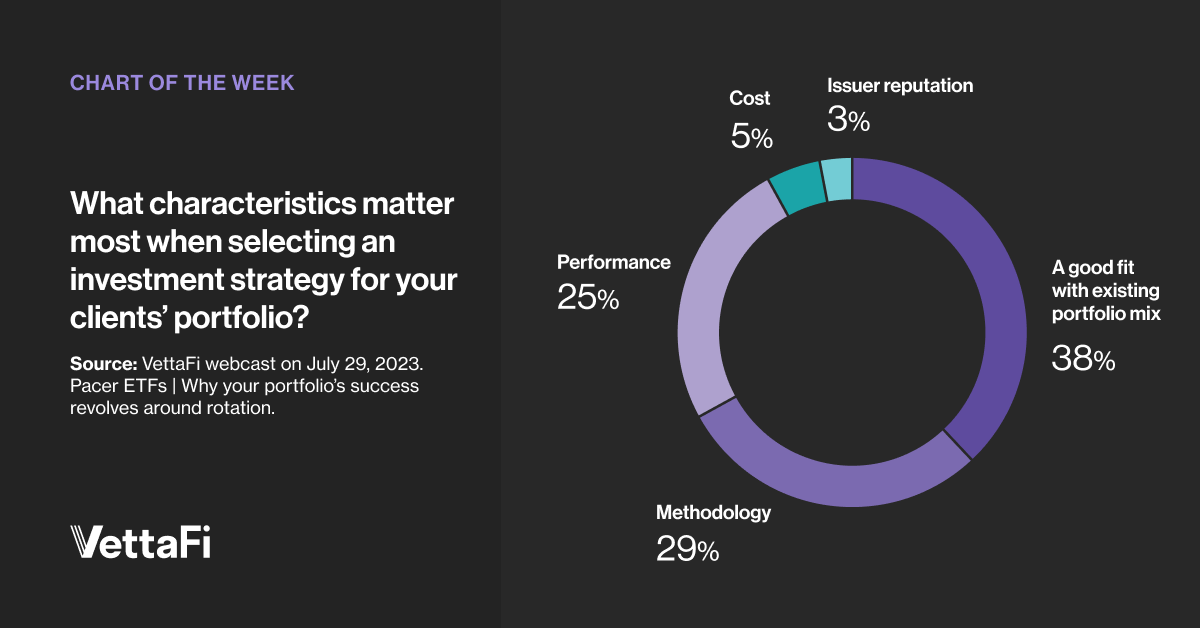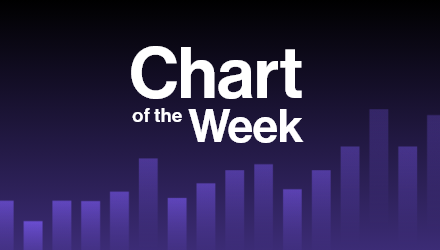How important is the cost of an ETF? Well, it depends on who you ask.
According to Charles Schwab, nearly 60% of ETF investors it surveyed in 2022 cited cost as the most important factor consideration when choosing an ETF. With that top of mind, it is not surprising that last week State Street Global Advisors cut the fees on 10 of its already rock-bottom priced “Portfolio” ETFs. In the documentation, the firm noted the higher fees on products from competitors such as iShares, Vanguard, JPMorgan, and Charles Schwab. But how important is the cost of an ETF to advisors? VettaFi found out that for many advisors, other things matter more than cost.
What Matters to Advisors When Selecting an ETF?
During a late July webcast with Pacer ETFs, we asked, “What characteristics matter most when selecting an investment strategy for your clients’ portfolio?” Cost received just 5% of the responses, a distant fourth after “a good fit with existing portfolio mix” (38%); methodology (25%); and performance (25%). Only “issuer reputation” was less popular among advisor attendees.

Looking to Europe? Make Sure You Look Around
The SPDR Portfolio Europe ETF (SPEU) is one of the ETFs that received a fee reduction last week. SPEU provides exposure to European heavyweights like AstraZeneca, HSBC, Nestle, Total, and SAP. The ETF now charges a miniscule 0.07% expense ratio, down from 0.09%, and is cheaper than the iShares Core MSCI Europe (IEUR) and the JPMorgan BetaBuilders Europe ETF (BBEU) by two basis points. SPEU is also now 51 basis points less expensive than the WisdomTree Europe Hedged Equity Fund (HEDJ). Yet, HEDJ has outperformed SPEU by nearly 500 basis points as of August 4 on a three-year annualized basis.
For advisors offering portfolios that are home-biased and hold hefty stakes in U.S. equities, the WisdomTree ETF might be a good fit. HEDJ is currency-hedged, which neutralizes U.S. dollar movements relative to the euro. Furthermore, the ETF’s methodology involves gaining broad exposure to European equities via dividend-paying exporting companies. The portfolio’s top positions included ASML Holdings, Banco Santander, L’Oreal, LVNH, and Mercedes-Benz. Because of its Eurozone focus, it does not include Swiss and U.K. companies.
We’re not saying HEDJ is or is not a better ETF than SPEU, but to choose one over the other requires diving deeper.
How Much Credit Risk Do You Want?
The SPDR Portfolio High Yield Bond ETF (SPHY) is another ETF that became even cheaper last week. SPHY’s expense ratio was cut in half to 0.05%, making it now less expense than the Schwab High Yield Bond ETF (SCYB), the iShares Broad USD High Yield Corporate Bond ETF (USHY), and the Xtrackers USD High Yield Corporate Bond ETF (HYLB) by five or 10 basis points. SPHY is significantly more appealing to cost-focused investors than other high yield ETFs like the Invesco Fundamental High Yield Corporate Bond ETF (PHB).
However, PHB is built differently than peers and might be a good fit for some advisors wanting to limit the credit risk undertaken. PHB’s underlying Research Affiliates index selects and weights securities based on an issuer’s book value of assets, gross sales, gross dividends, and cash flow. The resulting portfolio recently had 72% of assets in bonds rated BB, with 16% in BBB bonds, and 11% in B securities. In contrast, SPHY had 50% of assets in BB-rated bonds, 38% in B-rated bonds, and 12% in bonds rated lower than B.
PHB provides a more conservative approach to gaining high income. The ETF’s 30-day SEC yield was recently 6.6%, less than SPHY’s 8.4%. Choosing between them needs to be based on more than ETF costs.
For more news, information, and analysis, visit the Modern Alpha Channel.








